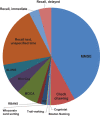Cognitive measures lacking in EHR prior to dementia or Alzheimer's disease diagnosis
- PMID: 33656251
- PMCID: PMC8359414
- DOI: 10.1002/alz.12280
Cognitive measures lacking in EHR prior to dementia or Alzheimer's disease diagnosis
Abstract
Introduction: The extent that cognitive measures are documented in electronic health records (EHR) is important for quality care and addressing disparities in timely diagnosis of dementia or Alzheimer's disease (AD).
Methods: Analysis of U.S. EHR data to describe the frequency and factors associated with cognitive measures prior to diagnosis of dementia (N = 111,125) or AD (N = 30,203).
Results: Only 11% of dementia patients and 24% of AD patients had a cognitive measure documented in the 5 years prior to diagnosis. Black race, older age, non-commercial health insurance, lower mean neighborhood income, greater in-patient stays, and fewer out-patient visits were associated with lacking cognitive measures.
Discussion: Extensive missing cognitive data and differences in the availability of cognitive measures by race, age, and socioeconomic factors hinder patient care and limit utility of EHR for dementia research. Structured fields and prompts for cognitive data inputs at the point of care may help address these gaps.
Keywords: Alzheimer's disease; Mini-Mental State Examination; dementia; electronic health records; electronic medical records; healthcare disparities; mild cognitive impairment; neurocognitive tests.
© 2021 Biogen, Inc. Alzheimer's & Dementia published by Wiley Periodicals, LLC on behalf of Alzheimer's Association.
Conflict of interest statement
N. Maserejian, H. Krzywy, and S. Eaton are employees and shareholders of Biogen. J. E. Galvin is supported by grants from the National Institute of Health (R01 AG040211 and R01 NS101483).
Figures


References
-
- Alzheimer's Association . 2020 Alzheimer's disease facts and figures. Alzheimers Dement 2020;16(3):391‐460.
-
- World Health Organization . Dementia: Key facts. Updated 19 Sept 2019. https://www.who.int/news‐room/fact‐sheets/detail/dementia. 2019.
-
- Owens DK, Davidson KW, Krist AH, et al. Screening for cognitive impairment in older adults: uS preventive services task force recommendation statement. JAMA. 2020;323:757‐363. - PubMed
-
- Alzheimer's Association . Early Detection and Diagnosis of Alzheimer's Dementia. Policy Brief. Aug 2017. Available online: https://act.alz.org/site/DocServer/Policy_Brief_‐_Early_Detection_and_Di.... 2017.
Publication types
MeSH terms
Grants and funding
LinkOut - more resources
Full Text Sources
Other Literature Sources
Medical

